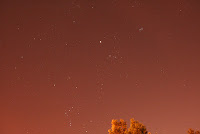 |
| View from my apartment doorstep, taken with iPhone 5 standard camera mode |
 |
| When I first saw this I thought my camera was broken. Combination of skyglow and glare. |
According to Wikipedia, light pollution comes in a number of forms:
- Light trespass (light spilling into a neighbor's yard or through a window)
- Over-illumination (excessive use of light)
- Glare (reduced contrast due to scattered light)
- Light clutter (excessive grouping of lights)
- Skyglow (glow over populated areas caused by light escaping and reflecting upward)
The two forms of light pollution that most affect my night photography are glare and skyglow.
 |
| Example of Skyglow |
 |
| Example of Glare |
My apartment complex uses two kinds of lights at night (see difference between blue/white and yellow/amber lights above). The most annoying are horizontally oriented lights that bathe the parking lot in a soft orange glow. From what I can find online, these lights appear to be sodium lights (based on the yellow/amber color). Because "white or blue-rich light contributes significantly more to sky-glow than an equal amount of yellow light," these yellow lights should be less of a contributing factor, if it weren't for their orientation (source).
These yellow lights are oriented at 90° above the nadir (e.g. they're oriented horizontally). The best lights to reduce light pollution are oriented at the nadir (or straight down) and shielded from the sides to keep light aiming straight down.
So while these lights WOULD contribute less to skyglow (if they were properly oriented and shielded) they also interfere in another way, by adding glare.
Because of glare, I'm unable to shoot anything near the horizon. Even when the light itself isn't in my field of view, I still have to contend with glare and its resulting reduction in contrast.
 |
| Glare |
 |
| Skyglow/Glare |
I think the strong rusty red color is more due to glare than skyglow. Skyglow in my area normally shows up as a white/yellow haze up to 40° above the horizon. However, if my lens is directed anywhere toward these horizontal lights, my image quickly floods with an orange glow. It's poison!
Check out this example of light trespass and over (necessary) illumination, the parking lot light is shining right into this poor sap's bedroom window and lighting the side of the building for no reason. That's definitely two in one!
Check out this example of light trespass and over (necessary) illumination, the parking lot light is shining right into this poor sap's bedroom window and lighting the side of the building for no reason. That's definitely two in one!
 |
| Example of Light Trespass and Over-Illumination |

No comments:
Post a Comment